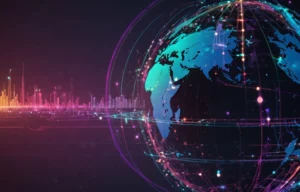

Artificial intelligence (AI) has the potential to transform industries and make life easier for millions of people. Now, AI is being used to fight poverty in many countries worldwide. The first step in using AI to combat poverty is understanding what causes it. Various factors, such as lack of access to resources, political instability, or economic inequality, can cause poverty. By understanding why poverty exists, AI can be used to create targeted solutions that address these issues. For example, AI can help fight poverty by providing access to resources such as education and healthcare. By connecting people with the resources they need, AI can help them escape or reduce their poverty.
Let’s look at a few examples of how AI technology can help raise communities out of poverty.
Generating Electricity
In many developing countries, people do not have access to electricity due to a lack of infrastructure or because they cannot afford it. However, AI can help to generate electricity for people in these countries by using data about wind patterns and solar radiation levels to identify the best locations for wind turbines and solar panels.
With electricity, these communities gain a source of light at night and the ability to tap into previously unavailable economic and educational opportunities. For example, lighting their homes can increase study time hours while providing them with electronic-based skills they need to boost their employability. Additionally, access to reliable and affordable electricity can spur small businesses to generate income and provide valuable community services. In short, access to electricity is essential in aiding communities to escape poverty, resulting in better living standards for everyone.
Providing Clean Water
Access to clean water is one of the fundamental cornerstones of a healthy life and sustainable livelihood. It is no secret that having a reliable source of potable water can serve as a lifeline of hope to people in poverty-stricken countries by providing access to food, cleanliness, and other basic needs. Unfortunately, many people worldwide do not have access to clean water due. AI can help to provide people in these countries with access to clean water by detecting sources of water contamination and working on ways to remove contaminants from water supplies.
Governments can make major strides toward reducing poverty levels by investing in water infrastructure projects such as wells, pumps, and reservoirs that supply affordable water to citizens. These investments have been found to have multiple benefits for society, including improved education and better health outcomes for generations. With increased access comes increased opportunity and empowerment, helping raise people out of poverty.
Improving Agricultural Yields
Agricultural yields are powerful forces for reducing poverty. They provide a reliable source of income, food security, and economic stability in less developed countries where agriculture is still a primary occupation. These increased yields offer higher crop incomes from the same amount of land, allowing farmers to better meet local needs or even export their goods at a profit. Moreover, not only do greater yields result in more affordable food prices for citizens, but they also represent opportunities for employment and entrepreneurship through agribusinesses.
Farmers in developing countries often lack access to the best farming practices, leading to poor crop yields. However, using data collected by satellites and leveraging predictive analytics, AI can help farmers improve their yields by providing information about things like irrigation and fertilizer use. Additionally, deep learning can help farmers prevent crop losses by identifying and detecting contamination issues earlier by analyzing photos of diseased crops.
Offering Financial Access
AI’s ability to sift through large amounts of data quickly and efficiently presents lower-income families with unprecedented opportunities for obtaining credit services. By leveraging predictive analysis, machine learning, and big data, AI allows lenders to accurately gauge their level of risk when providing loans to individuals with non-traditional credit histories, particularly those in lower income brackets or without a credit history.
This technology is a powerful tool for financial organizations, which can now provide low-cost or interest-free loans that are tailored to the specific situations of borrowers. These advances offer greater access to financial aid than ever before, allowing those in need to get on their feet and take advantage of economic opportunities no matter their financial background. Access to financial aid is particularly important for those living in poverty as it provides them an avenue for economic stability and mobility. The financial opportunities could drastically improve the quality of life, shifting the poor out of poverty and into a more secure future.
Providing Access to Education
In many developing countries, children do not have access to quality education due to a lack of resources. However, AI can help provide children in these countries with access to educational resources that can help them succeed in school, gain skills, and eventually secure jobs or opportunities to help them escape poverty. AI-enabled virtual learning systems have the potential to make education much more accessible for students from all backgrounds, including those who are economically disadvantaged. These platforms have already been implemented in some parts of the world with great success.
Students who previously had limited access due to financial constraints or location now have access to quality education regardless of their circumstances. Additionally, these platforms allow learners everywhere to gain knowledge about different fields such as technology, business management, and finance that would otherwise be inaccessible without attending college or university courses. As a result, communities have opportunities to potentially boost their career prospects and earning power.
Improving Health Care
Developing countries stand to benefit greatly from the incorporation of AI into healthcare systems. When resources are limited, AI can provide assistance by helping doctors diagnose and treat illnesses with greater accuracy and efficiency, ultimately improving the quality of care even with fewer resources. AI-driven automatic diagnosis tools can analyze patient data quickly and accurately and suggest appropriate courses of treatment in less time than traditional clinical interpreting algorithms, potentially eliminating much of the waiting time associated with continuous medical evaluation. With cheaper access to life-saving treatments and improved healthcare access in rural areas, AI can be a powerful tool for developing countries to drive more accurate medical outcomes where resources may otherwise be scarce or unavailable. A healthier population is a more productive population. Individuals who can maintain good physical and mental health will be more capable of taking advantage of opportunities that can increase their standard of living.
WEBINAR